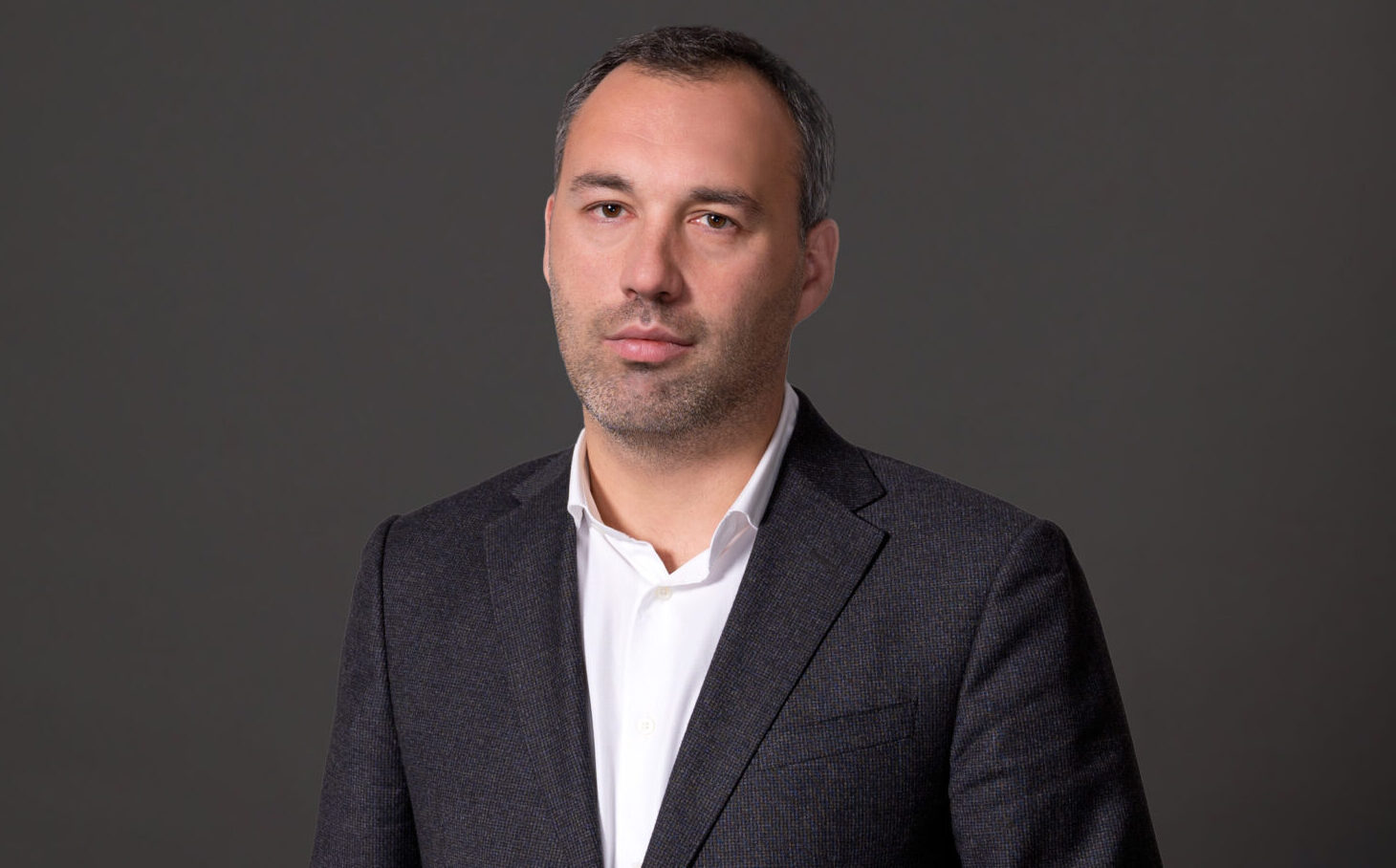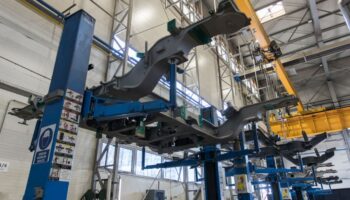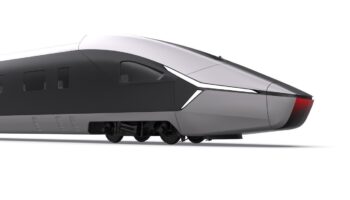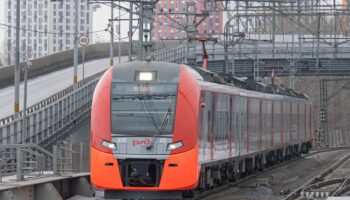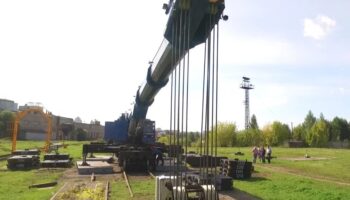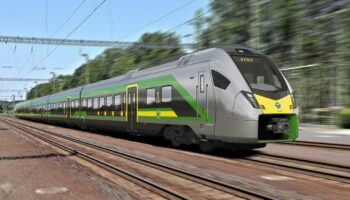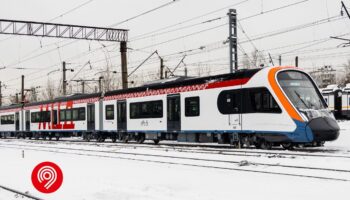Russia: The sanction pressure on the Russian economy and industry has led to a drastic revision of attitudes towards Russia’s role in the global supply chain. The first critical months having passed, the full technological sovereignty took priority over talks of the localisation levels. This change affected both the production of rolling stock and one of the major market players, Key Systems and Components Group of Companies (KSC GC). The group joins more than 30 manufacturers of components with annual production worth over RUB 70 bln ($0.9 bln). In the interview with ROLLINGSTOCK, Taras Spivak, CEO of KSC GC, spoke about operations in the new context.
Mr. Spivak, in 2022, KSC GC celebrated its fifth anniversary, and all these years the holding was showing intense growth. How do you keep all processes manageable and level the impact of the bureaucratisation increasing naturally?
These years, the holding has indeed been expanding intensively due to the goal it was set up to achieve. This goal is to consolidate Russia’s leading enterprises that produce components for rolling stock, optimise the structure of the holding, improve its technological and management processes to achieve synergy and be prepared to offer the railways industry necessary equipment.
Over five years, KSC GC has seen stages of heavy growth, centralisation, and at last decentralisation that was needed to optimise and restart management processes. At a certain point, we have lowered expectations and adjusted the roadmap so that the processes and projects already in place continue with the right level of manageability and quality.
Have you already chosen the activities you want KSC GC to focus on?
Last year, we focused on four product areas: climate control equipment, interior and exterior, electric equipment, and pre-production. By the end of the year, we decided to add the fifth area, braking equipment, and begin the implementation of a relevant project. These are the areas we will focus on in our development in the near future.
When are you going to introduce proprietary braking equipment?
As we began to set up the division only in Q4 2022, it is still premature to talk about it. The tasks of the division are extremely ambitious and crucial for the entire rail transport industry and, in the first place, for TMH as a main consumer of braking system components in Russia.
Before, these products were manufactured and supplied by a European manufacturer with a certain localisation level. In today’s context that company can no longer satisfy demand in full, and the industry has faced halted supplies of braking systems: shoe and disc brakes, and compressor packages. Although several Russian companies offer such products, they cannot comply with the required technical level and output.
We, of course, could not remain uninvolved, and at the end of the last year decided to develop a relevant competence. We set a task of mastering top-priority products in this area, such as shoe brakes, axle and wheel discs, and pincer mechanisms. By the end of 2023, we expect the division would start servicing and repair of existing braking systems of various rolling stock. First and foremost, those of metro cars. The production of new systems is scheduled to start in 2024.
As far as I know, another Russian market player, Transpnevmatika, moves in the same direction. Do you work on the project together or will it be KSC’s own business?
We work in parallel, each developing its competence. The demand is high, and one company will not cope with it.
The industry, however, needs other components like yaw dampers or automatic couplings while sanctions remain in force. Will KSC take steps in this direction?
KSC has never dealt with shock absorbers in a consistent manner. I understand that some Russian manufacturers already offer components manufactured locally. We produce a limited range of yaw dampers only to replace those used in the rolling stock, but we don’t develop any new advanced units.
One of the Russian companies manufactures couplings, including backlash-free ones, and it looks like the market counts on this company. That is why we don’t produce couplings.
Looking back at the events of 2022, would you say KSC is more likely to have benefited or suffered from them?
Both, of course. We suffered, we benefited, and we experienced enormous pressure from all possible sides, including from our consumers.
“Demand for new products has grown significantly, sometimes it exceeds our capacities. Logistical constraints slowed down the introduction of new products to the market. While we were limited in our ability to import subcomponents and parts and promptly deliver components, raw and other materials, the growing demand kept us from being idle”
The government did not delay decisions and promptly offered new tools to spur demand, develop production, reorganise supply chains. What we were granted is a major expansion of the mechanism to provide subsidies, low-interest loans, R&D grants, and much more. With such support, we launched an unprecedented number of new products in 2022 (for more information, please, see the note below the interview, note by ROLLINGSTOCK). Throughout the year, we initiated developments under some projects, and partially completed or began production under others. All the products we started to work on in 2022 are expected to enter production in 2023.
Last year, the Industrial Development Fund granted low-interest loans to companies of your group — Traks and Centre of Transport Equipment — to master the production of components for climate control systems and inter-car gangways. As I see it, the companies needed to purchase production facilities. What restrictions have you encountered?
As the equipment supply shrank, it has become more difficult to work. After some manufacturers left the Russian market, the logistics became much more complex. Sometimes, it was easier for manufacturers to opt out of supplying equipment at all. As a result, we had to purchase some products from manufacturers based in Eastern countries, and others from Russian ones. For all the projects that the holding launched in 2022, we managed to organise the production and supply of equipment to Russia.
In 2020, you said that one of KSC’s tasks was to reduce the share of sales from operations with TMH from 85% to 50% within a few years. What is your progress here?
Indeed, the task was exactly that. We needed to mitigate the influence of the main customer on our activities. It was not a question of a decrease in absolute values, but a reduction of a share. So, we needed to increase the revenue that other customers bring while keeping the same sales to TMH.
To solve the task, we employed different approaches and used both our own production facilities and the facilities of our partners that manufacture products for other markets. Later we stopped working in the areas that our partners are involved in and concentrated on our own competencies and on finding new customers.
“Public transport is one of the areas for active development today. Systemically important Russian bus manufacturers placed with us large orders for our climate control systems”
Our Climate Control Equipment division began to work on refrigerator equipment. We intensively develop equipment for wheeled refrigerators and later will proceed to refrigerator freight railcars. We expect to gain a stable position in the market in the next few years.
Although at this point we have mainly reorganised and optimised the companies of our Interiors and Exteriors division, last year we started devising interiors for the shipbuilding industry. This business unit is expected to start operating at full capacity in 2023. We have already received large orders from Russian shipbuilding companies and plan to set up a ship interior centre of excellence.
We are planning to enter the emerging market of aviation components, but I don’t expect here any significant revenues in the coming years.
That said, although the diversification task has not yet been solved, the groundwork we have made will significantly expand the presence of KSC GC in other segments of the machine-building market. It is important to bear in mind that the turbulence of recent years requires the business and industry to address the challenges of the external environment in a quick and flexible manner. Last year alone, we set a large list of completely new tasks for mastering components for rail transport.
To summarise, excluding TMH, how many major customers do you have now?
About ten.
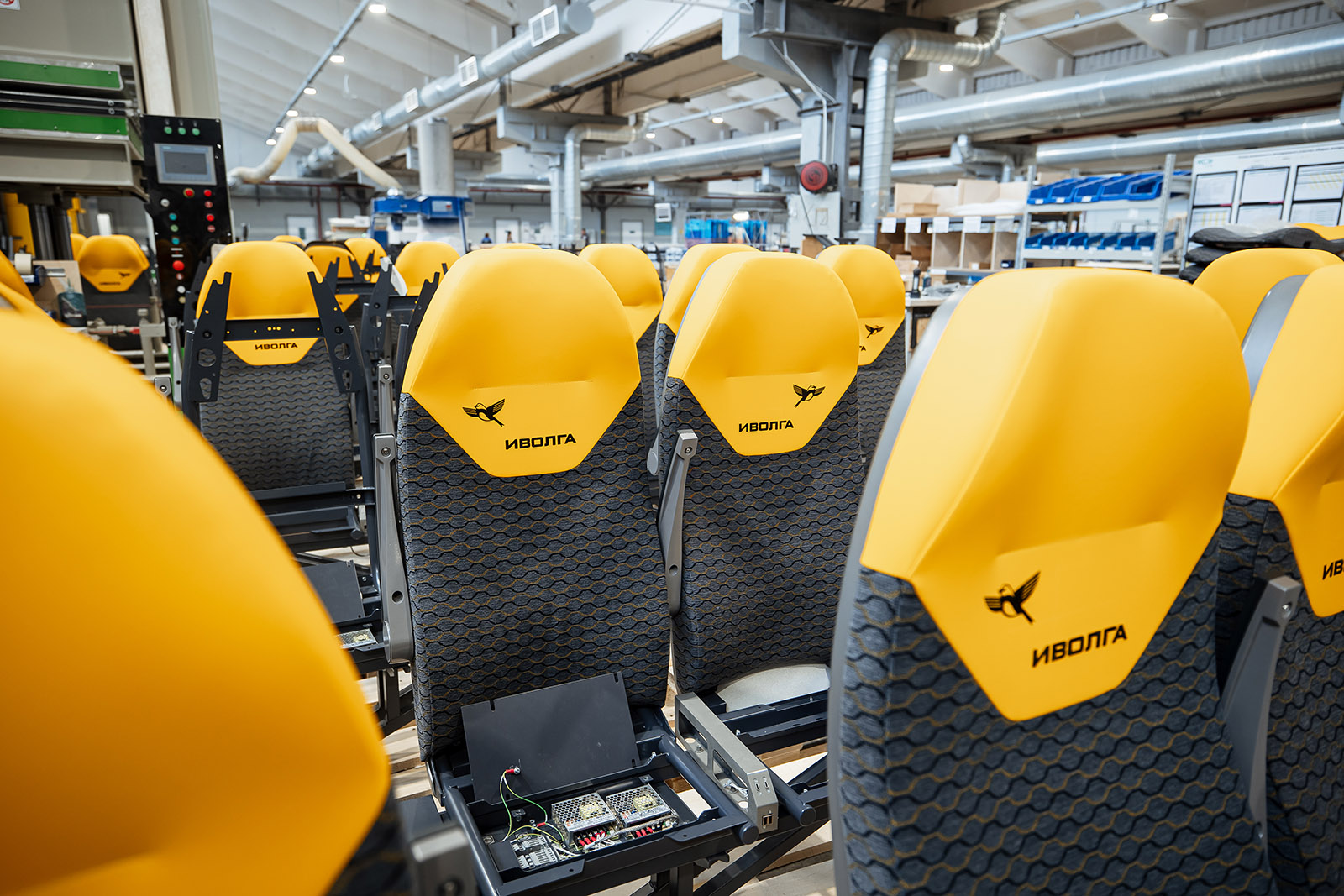 Taras Spivak: “Although the diversification task has not yet been solved, the groundwork we have made will significantly expand the presence of KSC GC in other segments of the machine-building market”. In the photo: seats for Ivolga 3.0 EMUs designed by KSC. Source: KSC GC
Taras Spivak: “Although the diversification task has not yet been solved, the groundwork we have made will significantly expand the presence of KSC GC in other segments of the machine-building market”. In the photo: seats for Ivolga 3.0 EMUs designed by KSC. Source: KSC GC
How did KSC’s share in the locomotive building market change over the past two years?
Sales of locomotive components grow in absolute terms and remain stable – given the expansion of the component range we offer for passenger rolling stock – in percentage terms. However, it will be a breakthrough year. I mean, electrical equipment for locomotives. After Elektrovypryamitel, a Saransk-based developer and producer of power semiconducting devices, became a part of our holding, we can offer more converter equipment for locomotives. We will start to supply equipment to the Novocherkassk Electric Locomotive Plant (a part of TMH, note by ROLLINGSTOCK). NPO Voyage, one of our companies, will supply, for example, cabins for its electric locomotives.
Could you describe your participation in the production of new TEM23 shunting and 3TE28 mainline diesel locomotives?
For TEM23 and also for EMKA2 battery-powered electric shunter, as their driver cabs are similar, we will supply climate control systems and plan to produce cabs. In the medium term, our Electrical Engineering division will start manufacturing complete sets of electrical equipment for TEM23 locomotives. A permanent magnet sync traction generator will be added to a standard set of a control system and traction converter.
For 3TE28 mainline locomotives, we supply climate control equipment. Our system is already installed in a prototype. We also plan to design the interior and exterior of this locomotive.
Since last year TMH adjusts prices for rolling stock its customers purchase. Do you index component prices, and how has the margin changed between now and then?
Indexation is the least-evil solution we have to recourse to in the context of real inflation and change in cost structure and supply. It can be said that all market players have lost much in the margin, and the closer a company is to an end product, the less the compensation for that loss.
Our procurement portfolio mainly consists of subcomponents, raw and other materials that are not tailor-made but are more of an industry-wide nature. Only a few suppliers can designate KSC GC as a key customer or can tell that our holding is the king of the hill. This is both good and bad. On the one hand, the supplier does not depend on us and if we order less that will not be a great problem. On the other hand, our orders cannot influence its pricing and activities.
“A guaranteed order, for example, by Russian Railways, ensures the sustainability of the OEM, i.e. of our holding as a supplier of key rolling stock components. However, if we go further the supply chain, this factor no longer applies to our suppliers of subcomponents and other products”
Thus, when prices for raw and other materials grow, we feel it in full but can do nothing to stop it, limit it, or pass it on to the suppliers. This is true for the entire range of electrical products. The prices for raw and other materials in this segment increased not by percent, but exponentially. First the pandemic, then the special military operation both accelerated the price rise.
Meanwhile, we could see the price spike in Q2 2022, and it was more like an emotional response from the market. In the second half of the year, the price rise slowed down and the reverse process began. Products that have doubled in price or more have become cheaper, and we have started to optimise the cost of production to avoid unwanted price indexation.
I can’t give you any more details about indexation, as it’s still a trade secret. But our customers certainly take into account how the macroeconomic situation affects us, too. One of this year’s tasks is to work assiduously with the cost of production.
Do you expect any lower cost of production due to scaling up?
No, the plans to lower the cost of production are based on last year’s purchases of all critical items. We decided then to buy subcomponents, raw and other materials at any price to ensure continuous production of both our products and rolling stock. Now we work in the cold light of day, build up inventories, and have the opportunity to negotiate better terms and choose suppliers and logistics schemes.
Do any potential suppliers of similar components from India, Türkiye, China, and Belarus come to the Russian market?
No, they probably don’t rush coming into the Russian market. They are willing to supply products manufactured in their own countries but not to localise production here. So we don’t feel any competition, and have the game in our hands.
What are KSC GC’s main strategic objectives for 2023?
If in 2022 we were “fighting fire” and taking more “extreme” steps to stabilise our operations and calm the situation, in 2023 we counter the effects. We will continue working on our technological sovereignty and replacing risk-related items in our products until this work is done. We are mastering the production of components we used to buy so that we are no longer dependent on third-party contractors and mitigate respective risks.
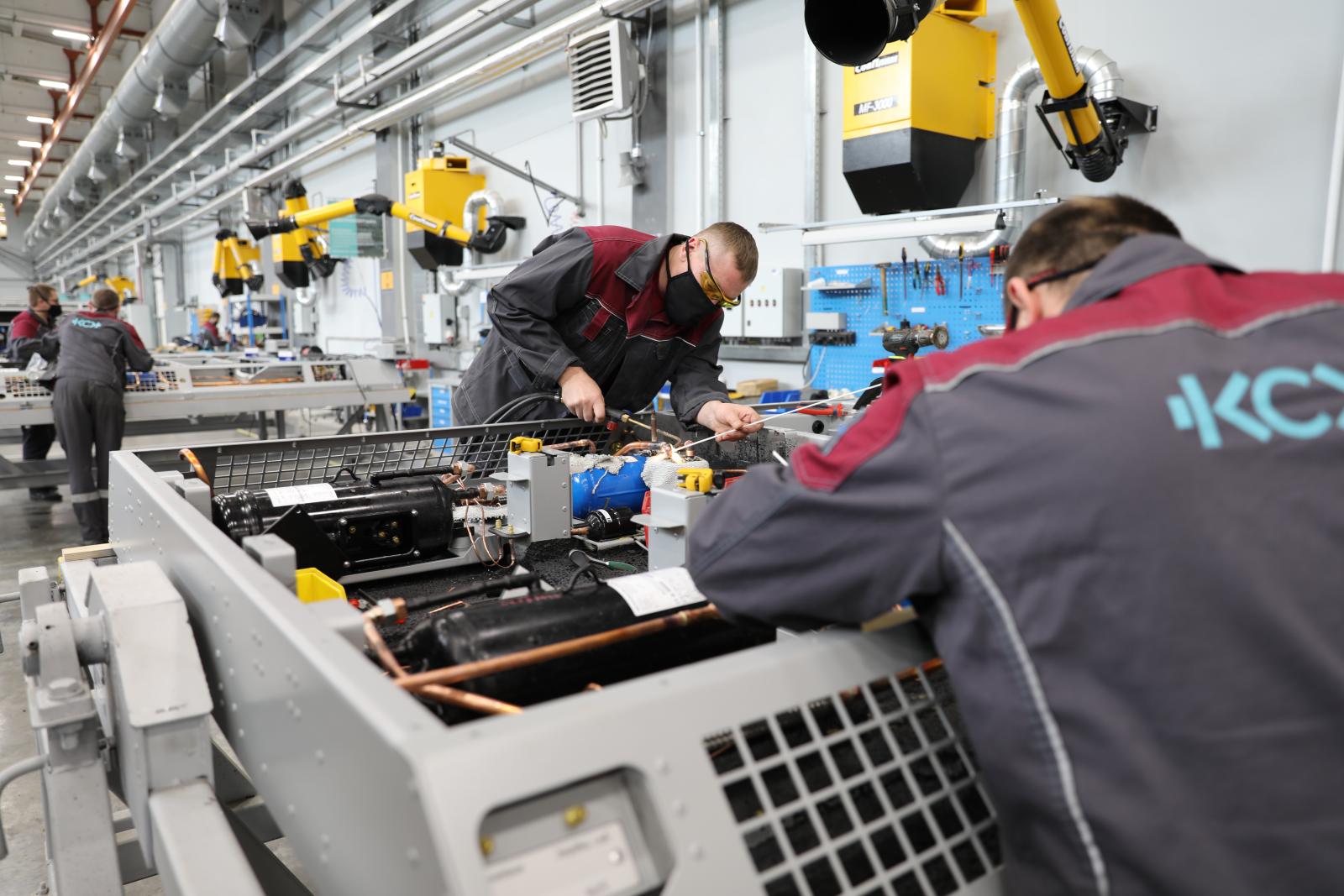 Taras Spivak: “We will continue working on our technological sovereignty and replacing risk-related items in our products until this work is done”. In the photo: production line for climate control systems at Transcon. Source: KSC GC
Taras Spivak: “We will continue working on our technological sovereignty and replacing risk-related items in our products until this work is done”. In the photo: production line for climate control systems at Transcon. Source: KSC GC
Could you give us some examples?
At the end of last year, we set up the production of compressor plants for metro trains, and this year, for the railway. Door systems are a shining example. Earlier, we produced them in cooperation with foreign partners. We manufactured door panels, and they produced operating gear and control units. Now we manufacture doors entirely ourselves and have developed our own gear with its mechatronic mechanism and control unit. I can think of many such examples.
What is the course of KSC GC’s patent work?
Over five years, we received 38 patents in electrical engineering, climate control equipment, interior and exterior, and patented two software applications. Obtaining a patent is mandatory when you use state support for production.
Last year, Knorr-Bremse announced its plans to use telematics hardware in its products and introduce a predictive analytics system available for subscribers. Have you thought about setting up a digital product division?
This area is of immediate interest to us. We conceived it when setting up the holding, and have employed this approach to monitor the condition of climate control equipment on EMUs. However, as a full-fledged project for the development of an automated monitoring system, the idea was implemented a year ago. Then several factors coincided, and KSC Elcom, one of our companies, received a grant for a project on the development of a smart locomotive-hauled coach with a monitoring system. For passenger coaches, we devise new electrical equipment with all necessary functions, including condition monitoring for the electrical equipment itself and consumers under its control.
We established a separate IT company, KSC Information Technologies. Together with KSC Elcom, the new company started implementing a project for the development of an equipment monitoring system, and in 2022 successfully completed its first phase. The prototype works with data on the operation of various components of a passenger coach. The system receives data from numerous sensors, decrypts them, forwards data batches for processing and interpretation, and allows automation of business processes for the creation and processing of repair and service requests.
“The system is deployed on the basis of our Data Center. The collected data are divided into 400–500 groups of technical parameters of components in a passenger coach depending on a series. The system can already be used to decrypt telemetry data received from a coach, and perform their retrospective analysis”
In the near future, we will continue working on the project. This year, we are going to develop an automation system to search for failures and pre-failure conditions of coach equipment, test and adopt relevant software, and deploy the system itself at other manufacturing companies of our holding.
Does it mean that you are creating, so to speak, a unified system and interface to enable a manufacturer and Russian Railways to exchange information on the operation of passenger rolling stock?
You’re absolutely right. As far as I know, both TMH and Russian Railways are ready to create such an ecosystem embracing all the aspects of passenger coach operation. In the longer term, we plan to add functionality to use the system with other rolling stock, such as EMUs and metro trains, and create a separate web service.
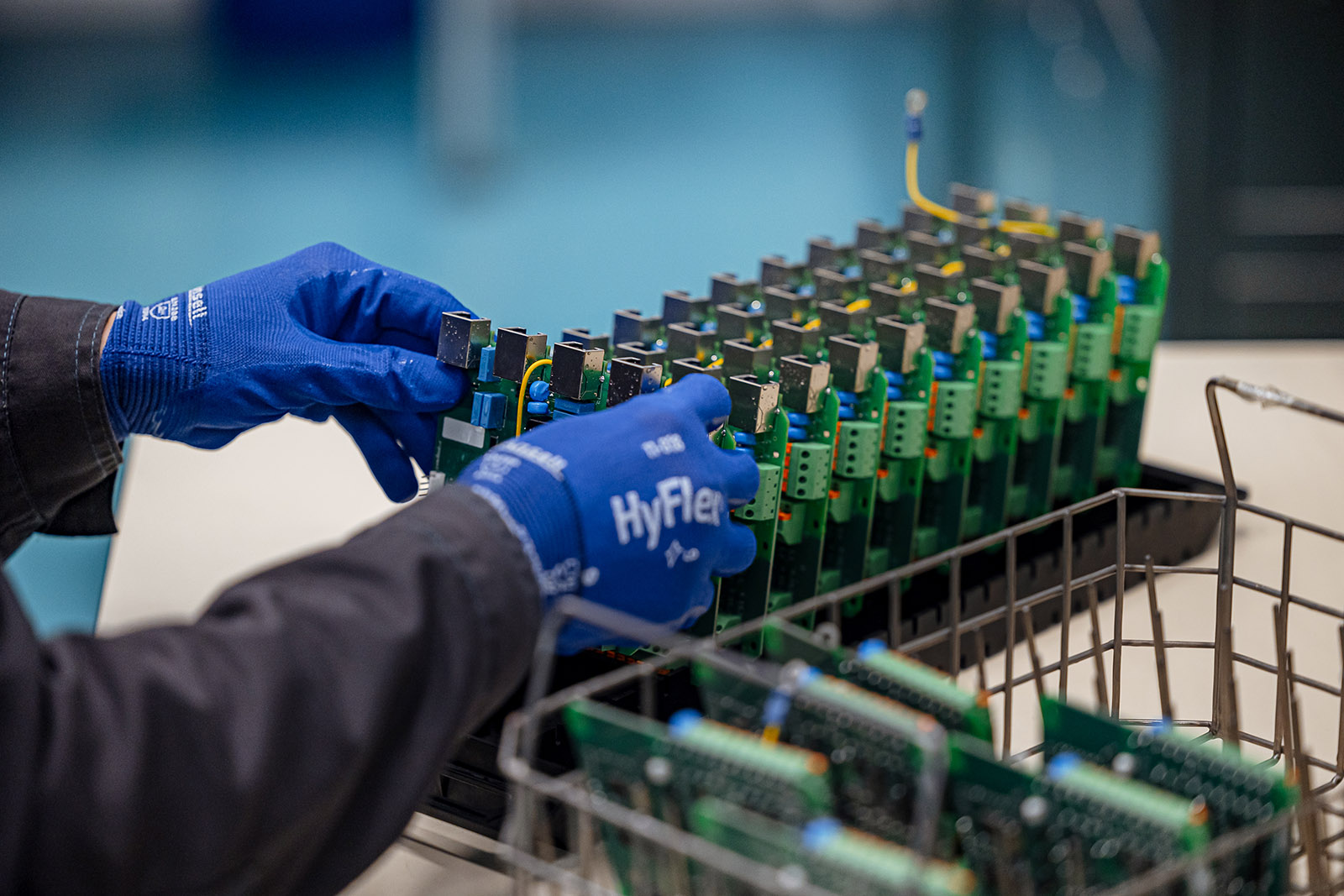 Taras Spivak: “KSC Elcom, received a grant for a project on the development of a smart locomotive-hauled coach with a monitoring system”. In the photo: printed boards manufactured by KSC Elcom. Source: KSC GC
Taras Spivak: “KSC Elcom, received a grant for a project on the development of a smart locomotive-hauled coach with a monitoring system”. In the photo: printed boards manufactured by KSC Elcom. Source: KSC GC
Do you continue attracting new export contracts?
For now our main resources are focused on meeting the significantly increased domestic demand. However, in case of interest from potential customers, we are open to all the opportunities to develop the export direction as well.
At the beginning of 2022, before all the crucial events, Jan Harder, CEO at RailNovation, in his column on our portal wrote that after decades of globalisation, the rail industry faced a supply chain crisis caused by the COVID-19 pandemic and began moving to regionalisation. In your view, have the recent events brought the era of the global component market to an end?
The world will, for a fact, not be the same. It will change, and so will the component market. I don’t think there will be many fully independent national systems. Every country cannot produce all types of raw and other materials equally well or at least at an acceptable level. I have not heard of Russia or other states aiming to achieve 100% industrial sovereignty.
Obviously, a new trend will emerge, a trend towards risk minimisation. It is extremely difficult to completely eliminate cooperation, imports, or exports. As the new conditions are beneficial to the development of national production, the overall national production and localisation level will increase considerably. However, the global market will certainly not disappear, and global competition as the most significant factor to determine the development and improvement of objective competitiveness will not disappear, too.
Interviewed by Sergey Belov
Translated to English and edited by Ekaterina Savenkova
***
Bio
Born in 1980, Taras Spivak graduated from the Tver State University with a degree in law. After three years of working as a legal counsel in several organisations in Tver and Moscow, he joined the team of the Tver Carriage Works (TVZ), a part of TMH, at first as the head of legal and legal support director. In 2013, Taras became the TVZ’s commercial director, and in 2018 filled the position of CEO at KSC GC.
***
KSC GC in 2022: divisions and product development
Electrical Engineering specialises in complete drive systems and related electrical and electronic equipment for rail transport. Its 10 sites of more than 82,000 m2 employ over 3,200 people. In 2022, the division launched the manufacture of more than 60 products and equipment sets for metro, electric trains, and locomotives, and more than 30 pilot batches of hi-tech products. Electrical Engineering began R&D in several areas, including the adoption of domestic power electronics and 100% localised sets of traction drives, control systems, and electrical equipment for metro cars operated in Moscow and Saint Petersburg and EGE2Tv Ivolga EMUs.
Climate Control Equipment develops and manufactures a wide range of climate control products and disinfection systems for transport. Its four sites of 23,000 m2 are located in three Russian regions and employ over 800 people. Last year, the division launched the manufacture of 9 new products, including climate control equipment for rail, urban and public transport, special vehicles, river, and sea transport. By the end of 2022, the portfolio of Climate Control Equipment included 81 products. More than 30 R&D projects are focused on various tasks, including selecting alternatives to replace foreign-made components.
Interior and Exterior produces components for the interior and exterior of the metro, rail, and urban transport. Its two production facilities of 65,000 m2 are located in four Russian regions and employ over 2,400 people. In 2022, the division launched the manufacture of 8 new products, among them doors for EGE2Tv Ivolga 3.0 and EP2D EMUs, Baltiets and Moscow-2020 metro trains, Class III armchairs, interiors, and furniture, etc. Interior and Exterior began R&D in four areas. For metro cars, it devises a new standardised door with a drive module and seats, and for multiple units and locomotive-hauled passenger coaches, sofas, and a vacuum sanitary module.
Pre-Production provides the entire cycle of such preparation works as procurement of materials, process preparation, quality control, and delivery of finished products. The list of operations performed by the division includes cutting, blanking, machining, forging, pressing, heat-treating, welding, painting, woodworking, assembling, casting, and electroplating. In 2022, Pre-Production launched the manufacture of more than 100 products used in components for metro cars, EMUs, and locomotives. Its 16 production sites of 226,000 m2 are located in three Russian regions, have more than 2,800 units of equipment, and employ 5,500 people.



